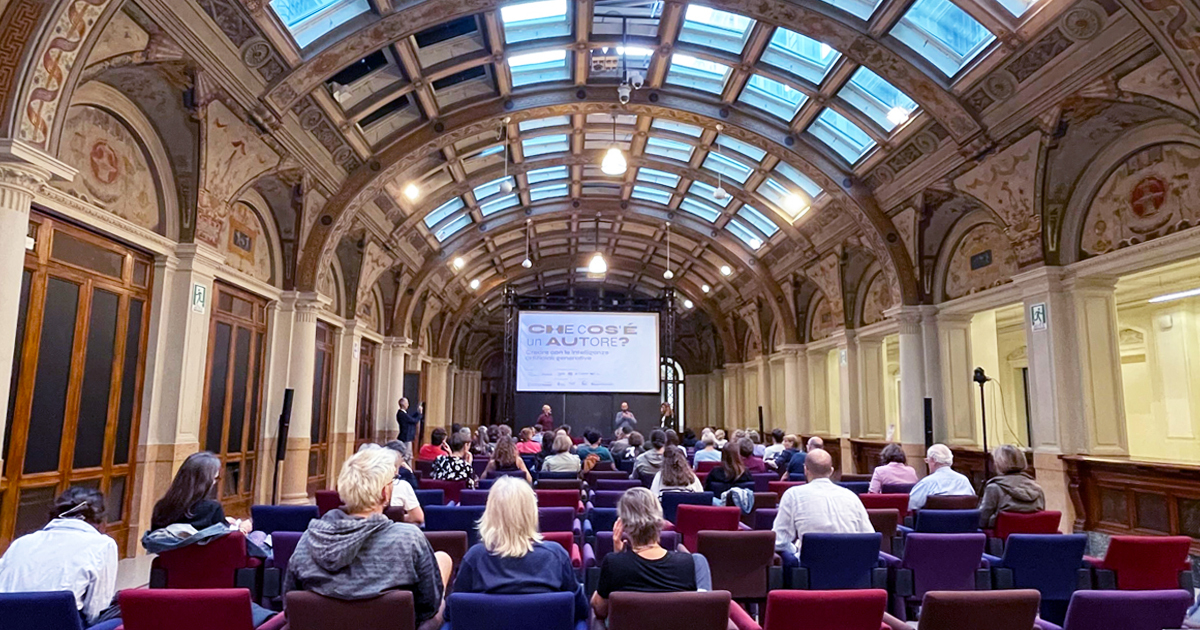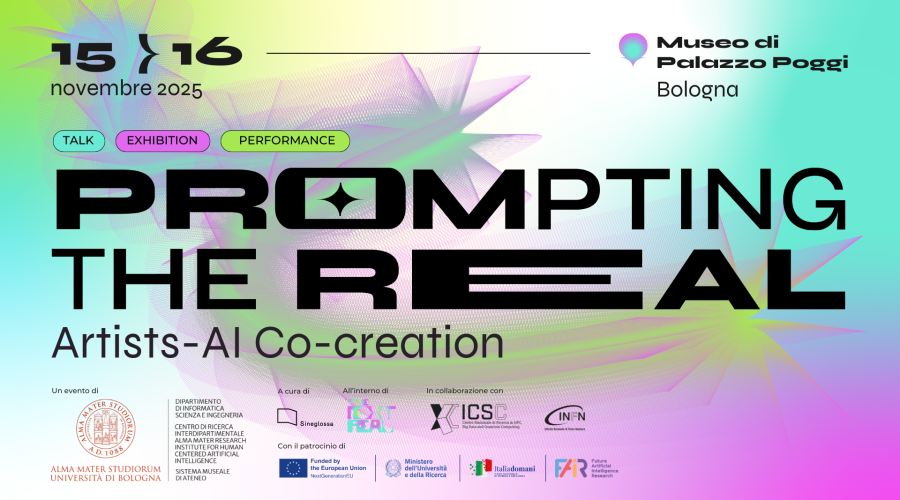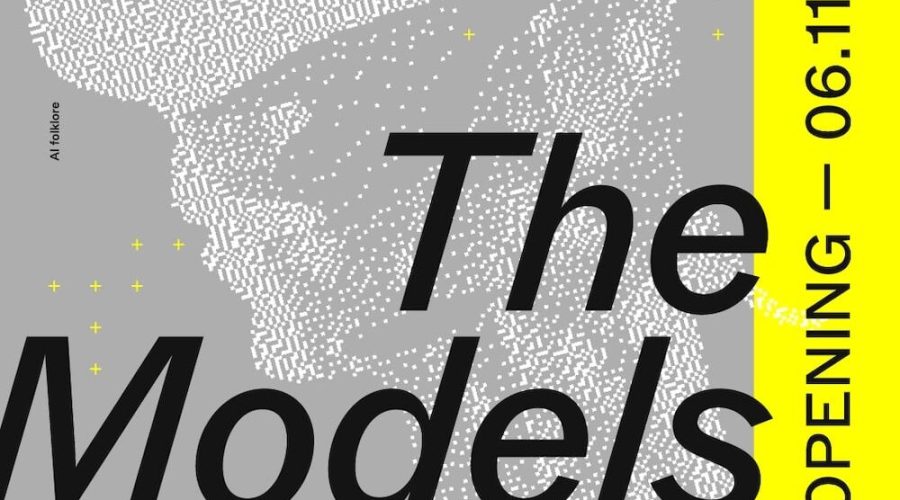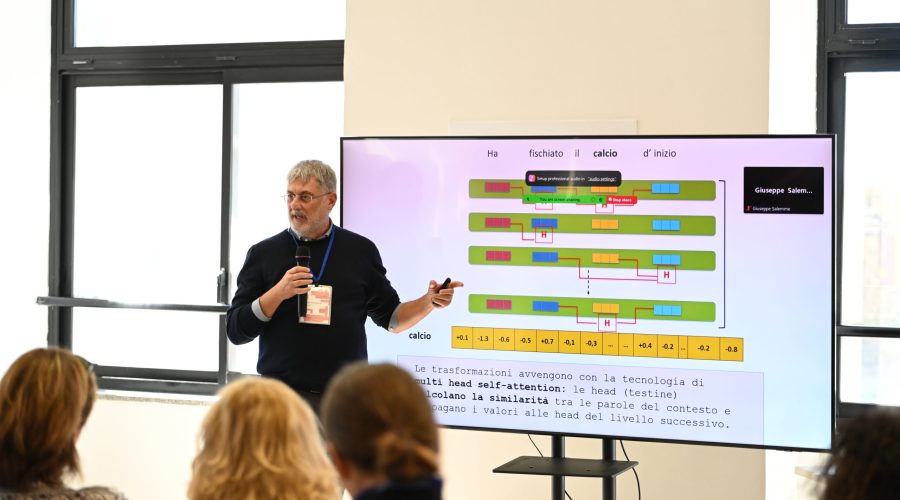The rise of artificial intelligence and its ability to generate creative works poses new questions about the notion of authorship. Who is the author of a painting created by an algorithm, or of a poem generated by a linguistic model? The conference Che cos’è un autore – Creare con le intelligenze artificiali generative (What is an author – creating with generative AI) held in Bologna on September 25th, organised with CINECA as part of the GRIN STARTS and European Digital Deal projects co-funded by the European Union, offered a valuable contribution to this debate, bringing together experts from different disciplines to explore the philosophical, legal and artistic implications of this new frontier.
The conference topics
Authorship is an evolving concept
The talk by Professor Leghissa emphasised the implications on a philosophical level. On the one hand, he highlighted the fact that cybernetic machines show the technical and combinatory nature of our language and artistic-literary production, expanding the types of artefacts with which human beings have co-evolved. For, as Leghissa argues, although machines do not think, human beings behave as if they were thinking, and, despite the absence of the ‘agency’ of artificial intelligence – which should make us refer to a ‘cybernetic machine’ and not an ‘intelligent machine’ -, such softwares are nonetheless capable of creating works with meaning, as Calvino had already noted in 1967, in the well-known essay Cibernetica e Fantasmi (Cybernetics and Ghosts).
On the other hand, throughout his talk, Leghissa places the question of authorship in the more general context of social and institutional dynamics. He emphasises how the cybernetic machine, like all the technological objects that inhabit our ecological niche, is part of a control apparatus, the same one within which the discourses of art and literature are produced, which determine the spaces of freedom with which the author can make use of the new technologies. Thus, in this context, ‘building margins of freedom’, says Leghissa, ‘I believe depends only on us as citizens of democratic countries, who cherish the liberating and emancipatory value that art has always had’.
On artistic and intellectual property in the digital age
The talk by Professor Francesca Lagioia addresses the legal and conceptual issues associated with the idea of the creative capacity of artificial intelligences. First of all, she raises the issue of the different types of creativity that exist: combinatory creativity (combining known elements in new ways); exploratory creativity (innovating within an existing pattern, as in the case of Mozart’s Requiem); and transformative creativity (creating a new conceptual field, as was the case with impressionism), a type, the latter, that AI does not currently possess.
On a legal basis, the debate on the creation of works of art through artificial intelligence, Lagioia points out, has to be tackled on two levels: 1) whether and how copyright-protected data can be used to train AI models; 2) whether and how AI can imitate not only specific works but also the ‘artistic personality’ of an author. Regarding the first matter, on the one hand, requiring consent would help authors benefit from their works; on the other hand, requiring consent would make the development of AI models more costly and less accessible for those who are less wealthy, consolidating the monopoly of a few large tech companies.
As for the second topic, it opens up the question of a possible competition between artists and a ‘digital doppelgänger’, which would risk mimicking human creativity – as shown in 2016 by Microsoft’s experiment The Next Rembrandt – opening up the debate on the need for new concepts, such as those of ‘artistic identity or personality rights’, in addition to copyright.
The European regulation, particularly the AI Act, includes the right of objection for authors (text and data mining), but this would entail the need to retrain models from scratch in case an author objects, a highly complex and costly operation. The discussion, Lagioia concludes, highlights the need for a balance between the rights of authors and the technical practicality of such regulations, especially for language models also used in non-creative contexts.
Authorship and Accountability
In the third talk, Professor Maurizio Lana went over some historical reflections on the nature of authorship, pointing out that this historical era was not the first to deal with the complexity of the subject. St. Bonaventure of Bagnoregio in the Middle Ages already distinguished various roles (scribe, compiler, commentator, author) for those who produced texts. In this sense, AI can be seen as a continuation of this debate, and not as a clean break from the past. The new issues that authorial identity raises in relation to digital tools are, for instance, the importance of establishing clear accountability. In a world where AI participates in the creation of content, who is held accountable? ‘If we divorce authorship from the human subject, who will we hold accountable for what has been written? To an artefact or to the person who used it?’ wonders Lana. In the humanistic field, there is a tendency of considering AI as endowed with a kind of autonomous creativity, but this could lead to reducing the human being to a ‘fungible machine’, similar to the AI systems that the human being has created: according to Lana, it is thus necessary to maintain a distinction between the human subject and the machine, and to consider technology as a writing tool, rather than an independent author. Recalling Maurizio Ferraris’ concept of documental responsibility, according to which every document should have a responsible party, in a society such as ours, which is based on documents (contracts, certificates, etc.), attributing authorship to AI systems could create a society in which the concept of personal responsibility is blurred, or distributed in an unclear way.
As for the second topic, it opens up the question of a possible competition between artists and a ‘digital doppelgänger’, which would risk mimicking human creativity – as shown in 2016 by Microsoft’s experiment The Next Rembrandt – opening up the debate on the need for new concepts, such as those of ‘artistic identity or personality rights’, in addition to copyright.
The European regulation, particularly the AI Act, includes the right of objection for authors (text and data mining), but this would entail the need to retrain models from scratch in case an author objects, a highly complex and costly operation. The discussion, Lagioia concludes, highlights the need for a balance between the rights of authors and the technical practicality of such regulations, especially for language models also used in non-creative contexts.
Human creativity as a historical and collective phenomenon
Francesco D’Isa goes on to recall how the invention of photography had already raised concerns about authorship, leading the society of the time to question whether the author was the photographer, or the camera. AI represents just one of the forms of automation that human beings have always used to extend their creative abilities. Just like the use of perspective in the Renaissance, automation, although lacking agency and intentionality, has its own, autonomous form of life, which transcends man’s use of that automation, and to which the artist delegates part of their work. Authorship, D’Isa notes, is a cultural illusion, particularly rooted in Western society, which tends to idealise the author as an independent creative figure. But the author is not so much a single creative entity as a collective and historical phenomenon: every work of human genius is intrinsically collective, the result of a combination of cultural, social and material influences. The fact that there is a need to identify an single author serves more the needs of responsibility and economic remuneration than a real ontological distinction. Still on this provocation, D’Isa then asks why the authorial role is so important for our society: ‘The illusion of individual authorship is a reassurance that we employ in order to recognise the human being as the creator of his own destiny and his own works, to avoid recognising the mechanics of our acts and our thinking’.
AI to exceed the limits of human imagination
Artist Roberto Fassone, on the other hand, tackled the topic of authorship by sharing the experimental and personal approach through which he uses artificial intelligence in his artistic production. In his work, he says, AI is not a technical tool for achieving predetermined results, but a medium, a channel that allows contact with unknown dimensions, similar to a bridge between different worlds. This point of view recalls an almost ‘spiritual’ or ‘esoteric’ practice in interacting with AI, which goes beyond its mere technical use. By using poetic and metaphorical prompts in AI such as Midjourney, Fassone was able to obtain images that seemed to emerge from a different ‘frequency’ – ‘I was in a kind of séance with the machine,’ he reports. According to his experience, AI could help us overcome the limits of our imagination, by creating new forms of expression and new ways of feeling and interpreting the world.
AI as co-choreographer and performer
Also in the context of exploring how authors understand their role in the creative relationship with non-human authors such as artificial intelligences, during the conference artist Kamilia Kard illustrated her relationship with AI through a project entitled Herbarium Dancing for an AI. The project shows an AI acting as a ‘choreographer’, interpreting and translating human movements into new forms. At first, the author attempted to accurately transfer the dancers’ movements to a digital environment (in the Roblox metaverse); during the process, errors, unexpected variations and movements that neither the artist nor the dancers had imagined occurred. The artist’s role was then to take these errors as the representation of a kind of AI authorship, and transforming them into an artistic element. At this point, Kard passed these movements to the dancers, asking them to learn the choreography that the AI had generated, and applied it to the digital plants in the project, trying to maintain their ‘plant nature’. To make the plants compatible with human movements, she created an anthropomorphised version that evolved into a kind of inter-species dance. With this project, Kard showed the possibility of a ‘mediating’ and ‘co-choreographing’ AI that, by interacting with human and plant elements, went beyond the original artistic intention, opening up new expressive possibilities.
Authorship as a Filter of our Collective Imagination
And finally, writer Wu Ming 2 emphasised that authorship is often a process of elaboration rather than an act of absolute creation: the author chooses, re-elaborates and re-interprets the collective imagination, filtering common influences and references into a work, with the intention of producing a ‘new’ text. In this process, as long as the author is human, it is possible to trace the origin of the information and references used in a work.
This traceability is lost when using AI systems, as it is difficult to clearly identify the sources and origin of the material used for the training. Regarding the discussion on the intention and the production of meaning by works created with AI, according to Wu Ming 2, the meaning depends on human intentionality, which is missing in a machine. Other questions open up regarding the issue of work, on an ethical and economic level, because there is a widespread tendency to devalue human work when it is the result of collaborations with machines. Furthermore, the intensive use of AI, especially in creative processes, requires a great deal of energy, contributing to a significant environmental impact. This aspect represents a hidden cost of working with machines, often overlooked in the debate on AI and creativity.
Relive the conference
The conference speakers
Giovanni Leghissa
Giovanni Leghissa (Trieste, 1964) is Associate Professor at the Department of Philosophy and Educational Sciences, University of Turin. Editor of ‘aut aut’ and director of the online philosophy magazine ‘Philosophy Kitchen’. He has taught philosophy at the Universities of Vienna, Trieste, and at the Hochschule für Gestaltung in Karlsruhe. His publications include: L’inconscio e il trascendentale. Saggi tra filosofia e psicoanalisi (Orthotes, Napoli-Salerno 2022); Per la critica della ragione europea. Riflessioni sulla spiritualità illuminista (Mimesis, Milano 2019); (con G. Becchio) The Origins of Neoliberalism (Routledge, London 2016); Postumani per scelta. Verso un’ecosofia dei collettivi (Mimesis, Milano 2015); Neoliberalismo. Un’introduzione critica (Mimesis, Milano 2012). Incorporare l’antico. Filologia classica e invenzione della modernità (Mimesis, Milano 2007). Il gioco dell’identità. Differenza, alterità, rappresentazione (Mimesis, Milano 2005). He edited, with Enrico Manera, the volume Filosofie del mito nel Novecento (Carocci, Roma 2015). His investigations focus on: phenomenology, psychoanalysis, epistemology of economics, epistemology of the human sciences (with particular reference to anthropology, history of religions, classical philology and biblical philology), philosophy of the post-human, philosophy of technology, the relationship between religion and modernity, contemporary Jewish thought, intercultural philosophy, Postcolonial and Gender Studies.
Maurizio Lana
Maurizio Lana is Associate Professor of Library and Information Science at the University of Eastern Piedmont. He co-directs the digital library of Late Latin digilibLT with Alice Borgna. He is a founding member of AIUCD (Association for Humanistic Informatics and Digital Culture). He served on the AIUCD board from 2011 to 2017; and then from 2020 to 2023. He served on the steering committee of EADH (European Association of Digital Humanities) from 2012 to 2018. He served on the steering committee of ADHO (Alliance of Digital Humanities Organisations) from 2014 to 2020 as Chair of the Multilingualism and Multiuculturalism Standing Committee. Recent publications on artificial intelligence and authorship include:
- «Intelligenza artificiale e produzione di testi: una prospettiva storico-critica | AIB studi». AIB Studi 62, fasc. 1 (giugno 2022): 1–28.
- «Sistemi di Intelligenza Artificiale e problemi del concetto di autore. Riflessioni su prodotti editoriali recenti». JLIS.it 13, fasc. 2 (2022): 13–44.
- «L’agency dei sistemi di Intelligenza Artificiale. Un punto di vista bibliografico». Digitcult. Scientific Journal on Digital Cultures 7, fasc. 1 (settembre 2022): 65–77.
- «Infiltrazioni di Intelligenza Artificiale». In Guardando oltre i confini. Partire dalla tradizione per costruire il futuro delle biblioteche. Studi e testimonianze per i 70 anni di Mauro Guerrini, a cura di Giovanni Bergamin e Tiziana Possemato, 167–79. Roma: AIB, 2023.
- «Leggere l’IFLA statement on libraries and Artificial Intelligence al tempo di ChatGPT». Biblioteche oggi Trends 9, fasc. 1 (2023): 4–12.
- «Automi di ieri e sistemi di Intelligenza Artificiale di oggi: umani, troppo umani». Post. Leggere, scrivere e far di conto. Informatica Umanistica e Cultura Digitale: il blog dell’ AIUCD, 5 luglio 2023.
- «Biblioteche e intelligenza artificiale: dalle Linee guida IFLA al problema dell’agency». In Biblioteche, lettura, intelligenza artificiale. Struttura e contesto del progetto Reading(&)Machine, a cura di Fabrizio Lamberti, Marco Mellia, e Maurizio Vivarelli, Editrice Bibliografica., 63–85. Biblioteconomia e scienza dell’informazione 52. Milano, 2024.
- «Extremely productive authors (EPA): alcune riflessioni sulla crescita dei ricercatori “estremamente produttivi”.» Post. Informatica Umanistica e Cultura Digitale: il blog dell’ AIUCD, 30 marzo 2024.
- «L’Intelligenza Artificiale ed il problema dell’agency dal punto di vista bibliografico». In II Seminario italo-spagnolo di Biblioteconomia e Documentazione, a cura di Andrea Capaccioni e Paola Castellucci, 47–60. Milano: Ledizioni, 2024.
Francesca Lagioia
Francesca Lagioia is Part-time Professor at the European University Institute in Florence and Senior Assistant Professor at the University of Bologna, where she teaches Ethics for AI and Computational Ethics; AI, Law and Society and ICT Law. She deals with the ethical-legal problems of artificial intelligence, computable methods of legal reasoning, and building artificial intelligence systems capable of identifying violations committed by humans or other AI systems.
Roberto Fassone
Roberto Fassone lives and works between Florence, Asti, and the metaphors we inhabit. His practice is about the extravagance of our lives. In recent years he has exhibited and realised his work in national and international venues. Among others: Maison du Savoir, University of Luxembourg (2023); Ars Electronica, Linz (2022); Visions du Réel, Nyon, (2022); 25th Gabrovo Biennial of Humour & Satire in Art, Gabrovo (2022); Macro, Rome (2022); MAXXI, L’Aquila (2021); Mattatoio, Rome (2021); Lo schermo dell’arte, Florence (2021); IIC, Paris (2020); Fanta-MLN, Milan (2023-2019); MAMbo, Bologna (2018); OGR, Turin (2018); Castello di Rivoli, Turin (2017); MOCAK, Krakow (2017); Quadriennale di Roma (2016); AOYS (online), Zkm, Karlsruhe (2015). He is co-founder of the publishing house Roi de Coupe. His practice is open to collaboration: in recent years he has worked with Jacopo Jenna, Kasia Fudakowski, Riccardo Banfi, Francesco Fonassi, Valeria Mancinelli, Mattia Pajè, Giacomo Raffaelli. He was awarded the Maxxi BVLGARI Prize for Digital Art in 2023.
Francesco D'Isa
Francesco D’Isa, a trained philosopher and digital artist, has exhibited internationally in galleries and contemporary art centres. After his debut with the graphic novel I. (Nottetempo, 2011), he published essays and novels for Hoepli, effequ, Tunué and Newton Compton. His latest novel is La Stanza di Therese (Tunué, 2017), while his philosophical essay L’assurda evidenza (2022) was published by Edizioni Tlon. His latest publications are the graphic novel Sunyata for Eris edizioni (2023) and the essay La rivoluzione algoritmica delle immagini for Sossella editore (2024). Editorial director of the cultural magazine L’Indiscreto, he writes and draws for various magazines, both Italian and foreign. He is Professor of Philosophy at the Lorenzo de’ Medici Institute (Florence) and of Illustration and Contemporary Plastic Techniques at LABA (Brescia).
Kamilia Kard
Kamilia Kard is an artist and lecturer born in Milan. Her research explores how hyperconnectivity and new forms of online communication have modified and influenced the perception of the human body, gestures, feelings and emotions. He moves between different media including the printed image, the video game, the website, 3D printing, performance and the virtual environment. Her work has been exhibited in galleries, festivals and institutions nationally and internationally. She is a Doctor in Digital Humanities at the University of Genoa and Professor of Multimedia Communication and Virtual Reality and Paradigms of Complexity at the Brera Academy of Fine Arts, Milan.
Wu Ming 2
Wu Ming 2 has been part of the Wu Ming collective, a band of storytellers based in Bologna, since its inception. Their first novel, Q, published in 1999, is signed under the pseudonym Luther Blissett and has been translated into fifteen languages. Since then, the collective has published eight multi-written novels and two collections of short stories, as well as essays, comics, theatre plays, and the screenplay for the film ‘Lavorare con lentezza’, directed by Guido Chiesa. Wu Ming 2 is the author of ‘solo’ novels (Guerra agli Umani and Timira), reportages of paths and trails, theatre monologues (Razza Partigiana), circus shows (L’uomo calamita) and archive films (51, L’uomo con la lanterna, Il Varco). With his voice, he sings and declaims the lyrics of the Wu Ming Contingent, the musical section of the collective, now in its second album.
All Wu Ming/Luther Blissett books are published under a licence that allows their reproduction as long as it is not for profit.
Credits
Organized by
Within the projects
In collaboration with
Under the patronage
Part of
The European Commission support for the production of this publication does not constitute an endorsement of the contents which reflects the views only of the authors, and the Commission cannot be held responsible for any use which may be made of the information contained therein.







